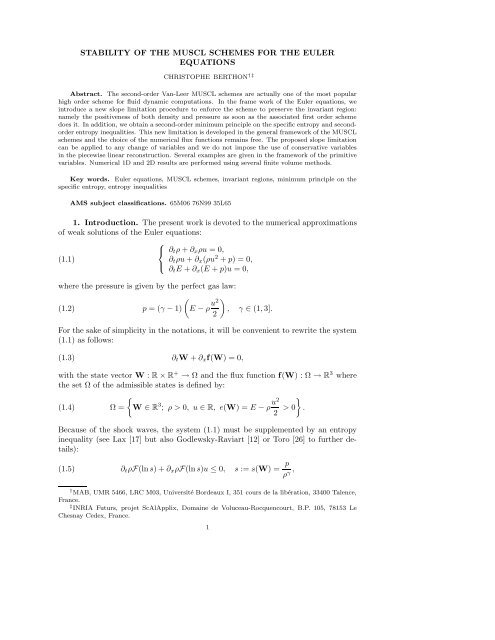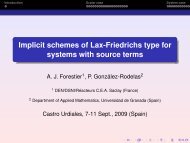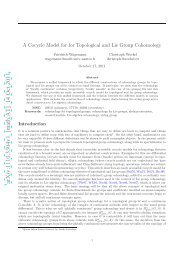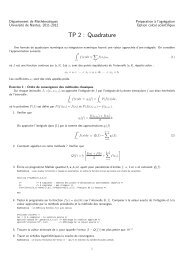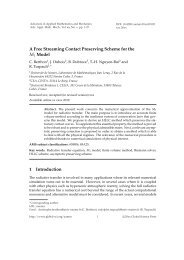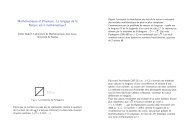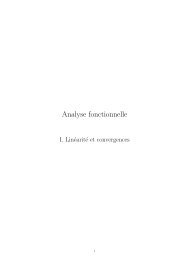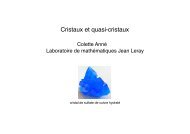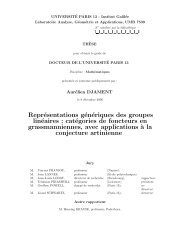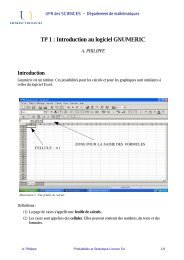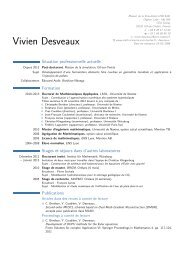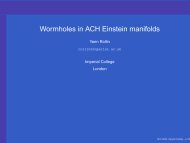STABILITY OF THE MUSCL SCHEMES FOR THE EULER ...
STABILITY OF THE MUSCL SCHEMES FOR THE EULER ...
STABILITY OF THE MUSCL SCHEMES FOR THE EULER ...
Create successful ePaper yourself
Turn your PDF publications into a flip-book with our unique Google optimized e-Paper software.
<strong>STABILITY</strong> <strong>OF</strong> <strong>THE</strong> <strong>MUSCL</strong> <strong>SCHEMES</strong> <strong>FOR</strong> <strong>THE</strong> <strong>EULER</strong>EQUATIONSCHRISTOPHE BERTHON † ‡Abstract. The second-order Van-Leer <strong>MUSCL</strong> schemes are actually one of the most popularhigh order scheme for fluid dynamic computations. In the frame work of the Euler equations, weintroduce a new slope limitation procedure to enforce the scheme to preserve the invariant region:namely the positiveness of both density and pressure as soon as the associated first order schemedoes it. In addition, we obtain a second-order minimum principle on the specific entropy and secondorderentropy inequalities. This new limitation is developed in the general framework of the <strong>MUSCL</strong>schemes and the choice of the numerical flux functions remains free. The proposed slope limitationcan be applied to any change of variables and we do not impose the use of conservative variablesin the piecewise linear reconstruction. Several examples are given in the framework of the primitivevariables. Numerical 1D and 2D results are performed using several finite volume methods.Key words. Euler equations, <strong>MUSCL</strong> schemes, invariant regions, minimum principle on thespecific entropy, entropy inequalitiesAMS subject classifications. 65M06 76N99 35L651. Introduction. The present work is devoted to the numerical approximationsof weak solutions of the Euler equations:(1.1)⎧⎨⎩∂ t ρ + ∂ x ρu = 0,∂ t ρu + ∂ x (ρu 2 + p) = 0,∂ t E + ∂ x (E + p)u = 0,where the pressure is given by the perfect gas law:)(1.2)p = (γ − 1)(E − ρ u2, γ ∈ (1, 3].2For the sake of simplicity in the notations, it will be convenient to rewrite the system(1.1) as follows:(1.3)∂ t W + ∂ x f(W) = 0,with the state vector W : R × R + → Ω and the flux function f(W) : Ω → R 3 wherethe set Ω of the admissible states is defined by:}(1.4) Ω ={W ∈ R 3 ; ρ > 0, u ∈ R, e(W) = E − ρ u22 > 0 .Because of the shock waves, the system (1.1) must be supplemented by an entropyinequality (see Lax [17] but also Godlewsky-Raviart [12] or Toro [26] to further details):(1.5)∂ t ρF(ln s) + ∂ x ρF(ln s)u ≤ 0,s := s(W) = pρ γ ,† MAB, UMR 5466, LRC M03, Université Bordeaux I, 351 cours de la libération, 33400 Talence,France.‡ INRIA Futurs, projet ScAlApplix, Domaine de Voluceau-Rocquencourt, B.P. 105, 78153 LeChesnay Cedex, France.1
2 C. BERTHONwhere the function W → ρF(ln s) is assumed to be convex. It is well known thatsuch a convex property is satisfied (see Godlewsky-Raviart [12], Tadmor [24]) as soonas the function F verifies:(1.6)F ′ (y) < 0andF ′′ (y)F ′ (y) < 1 , ∀y ∈ R.γTo simplify the notations, we introduce¯F(y) = F(ln y).By definition of F, let us note that ¯F is a decreasing function for all y > 0.In addition, as proved by Tadmor [24], the specific entropy s satisfies the followingminimum principle:(1.7)s(x, t + h) ≥ min {s(y, t); |y − x| ≤‖ u ‖ ∞ h} .The most usual and basic approach to approximate the solutions of (1.1) is basedon a piecewise constant approximation at the time t n :W n (x) = W n i , x ∈ (x i− 1 2 x i+ 1 2 ),where (x i ) i∈Z denotes the mesh nodes. We have set x i+ 12 = x i + (x i+1 − x i )/2. Forthe sake of simplicity in the present work, we will assume that the mesh is uniformwith the size ∆x. All the results stated in this paper easily extend to non-uniformgrids.The sequence (W n i ) i∈Z is defined by the following conservative scheme (see Harten-Lax-Van Leer[14], Godlewsky-Raviart [12], Toro [26], LeVeque [20]):(1.8)W n+1i= Wi n − ∆t)(F(Wi n ∆x, Wn i+1 ) − F(Wn i−1 , Wn i ) ,where the function Ω × Ω → F(W L , W R ) denotes the Lipschitz consistent numericalflux function (see [14, 12, 20, 26]). The time step ∆t is assumed to satisfy the CFLlike condition:(1.9)∆t()∆x max |λ − |, |λ + | ≤ 1i∈Z i+ 1 2 i+ 1 2 2 ,where λ ± are the numerical acoustic waves associated with the numerical flux functionunder consideration. The reader is refereed to [12, 20, 26] to complementaryi+ 1 2details about the finite volume methods for hyperbolic system of conservation laws.Additional stability properties can be proved for several schemes. The well-knownGodunov scheme [13, 20], but also the Lax-Friedrichs scheme (see Lax [18] or Tadmor[24] but also [20, 26]), the kinetic scheme as proposed by Perthame (see Khobalatte-Perthame [16], Perthame [21] and Perthame-Qiu [23]) or the Suliciu relaxation scheme(Bouchut [5], Coquel-Perthame [10], Berthon [4] for instance), satisfy the positivenessof the density and the internal energy, a set of discrete entropy inequalities (1.5) anda discrete formulation of the minimum principle on the specific entropy (1.7). In thesequel, the scheme (1.8) will be assumed to satisfy the following properties:P1: ρ n+1i > 0 and e n+1i > 0 whenever ρ n i > 0 and en i > 0.
<strong>STABILITY</strong> <strong>OF</strong> <strong>THE</strong> <strong>MUSCL</strong> <strong>SCHEMES</strong> 3P2: The conservative discrete entropy inequalitiesρ n+1i(1.10)¯F(s n+1i ) − ρ n ¯F(s i n i ) +∆t({ρ∆x¯F(s)u}(W i n , Wn i+1 ) − {ρ ¯F(s)u}(W)i−1 n , Wn i ) ≤ 0,for all functions ¯F = F◦ln with F satisfying (1.6), where {ρ ¯F(s)u}(W L , W R )denotes the numerical entropy flux function.P3: The minimum principle on the specific entropy(1.11)s n+1i≥ min(s n i−1, s n i , s n i+1).Several strategies have been proposed to increase the accuracy of the numericalsolutions. The high-order version of the first-order robust schemes is a very attractivesubject. The Godunov-type scheme certainly denotes the main class of second-orderscheme. It was largely studied in the last twenty years [2, 3, 6, 8, 9, 15, 16, 19, 21, 22,23]. Unfortunately, these procedures are, in general, based on the generalized Riemannproblem (see Ben-Artzi-Falcovitz [3] or Bourgeade-LeFloch-Raviart [7]). The solutionsof such problems are used with some benefits to establish stability properties likeentropy inequalities (see Coquel-LeFloch [9]). The computations of these solutionsturn out to be difficult and make the scheme poorly attractive. Several procedurehave been proposed to approximate the Generalized Riemann Problem.Actually, the most celebrate second-order scheme is the <strong>MUSCL</strong> scheme (see VanLeer [19]) which is systematically used in the industrial numerical simulations basedon the finite volume methods. These schemes extend any first-order scheme into asecond-order approximation using a very simple numerical procedure. It uses a betterreconstruction than a piecewise constant function since piecewise linear function inthe form(1.12)W n (x, t n ) = W n i + σn i (x − x i), x ∈ (x i− 12 , x i+ 1 2 ),are considered [20, 26]. The value σin denotes the slope of the linear function on thecell (x i− 1 , x 2 i+ 1 ) (see Figure 1.1). Several choice for the slope σn 2 i are proposed in[11, 12, 20, 26]. Some of these choices will be discussed latter on.In fact, the conservative variables W are not the most used and several papers(see [16, 23, 12]) consider a piecewise linear reconstruction on a relevant change ofvariables in the form:(1.13)κ(W n (x, t n )) = κ(W n i ) + σn i (x − x i), x ∈ (x i− 12 , x i+ 1 2 ),where κ denotes a smooth change of variables. For instance, the so-called primitivevariables (ρ, u, p) or the variables (ρ, u, s) enter this framework. For the sake of simplicityin the notations, the variables (ρ, u, s) will be denoted entropic variables in thepresent work.We consider the inner approximation in the cell i (see Figure 1.1) located atx = x i− 12 and x = x i+ 1 2. These approximations are denoted Wn,± iW n,±i = W n (x i± 12 , tn ).For the sake of simplicity in the remainder of the paper, we setand are defined by(1.14)W n,±i= W n i + ∆Wn,± i ,
4 C. BERTHONwhere the increment ∆W n,±iis defined by∆W n,±i= ± ∆x2 σn i ,in the case of linear function based on the conservative variables (1.12). If we considerlinear functions based on a change of variables (1.13), ∆W n,±i finds the followingdefinition:(∆W n,±i = κ −1 κ(Wi n ) ± ∆x )2 σn i − WinW n,+iW ni−1W n,+i−1W n,−iW niW n,−i+1W ni+1x i−1 x i x i+1Fig. 1.1. Piece-wise linear <strong>MUSCL</strong> reconstruction(1.15)In the sequel, we will denote conservative slope the following case:or equivalently ∆W n,−i(1.16)W n,−i+ ∆W n,+iW n,−i+ W n,+i= 2W n i= 0, while the general slope will be denoted by+ W n,+i ≠ 2W n i ,or equivalently ∆W n,−i + ∆W n,+i ≠ 0. Both situations will be considered in thepresent paper. In general, works devoted to stability properties of the <strong>MUSCL</strong>schemes (see Perthame [22] or Khobalatte-Perthame [16] for instance) solely considerthe conservative slope (1.15).The space second-order scheme writes:(1.17)W n+1i= Wi n − ∆t (∆xF(W n,+i, W n,−i+1 ) − F(Wn,+i−1 , Wn,− i )where F is the associated first-order flux function introduced in (1.8).The main difficulty lies on the construction of the vector increment ∆W n,±i . Alarge literature is devoted to this subject but essentially for the scalar conservationlaws and it is based on the Total Variation Diminishing criterion [9]. As emphasizedby Coquel-LeFloch [9], the total variation of a solution of (1.1), in general, is not adiminishing function of time. Thus, it is necessary to focus on properties (1.5) and(1.7).In the framework of the Euler equations (1.1), the <strong>MUSCL</strong> scheme (1.14)-(1.17)is used but, in general, the stability properties are not ensured. However, Khobalatte-Perthame [16] and Perthame-Qiu [23] exhibit (conservative) slope limitations in order),
<strong>STABILITY</strong> <strong>OF</strong> <strong>THE</strong> <strong>MUSCL</strong> <strong>SCHEMES</strong> 5to preserve the invariant region; namely the positiveness of both density and internalenergy. This result is established in the framework of the kinetic scheme with arelevant like CFL restriction. In Khobalatte-Perthame [16] a new limitation based onthe specific entropy is proposed to conjecture a discrete entropy minimum principle(1.11). In fact, it will be seen that this scheme enters the general approach developedin the present work (see section 2.2 devoted to the conservative slope).The scope of this paper is to extend the properties P1, P2 and P3 to the secondorder<strong>MUSCL</strong> schemes. Arguing a relevant CFL like condition, in the next section,we develop an easy slope limitation to preserve the invariant region by the<strong>MUSCL</strong> scheme (1.14)-(1.17). In addition, we establish second-order entropy inequalities(1.10) and a second-order entropy minimum principle. These results areproved in the general context of slope limitations (1.16) and next in the specific caseof conservative slope (1.15). In fact, our limitation will be understood as a correctionof the usual limitation functions. Concerning the choice of the numerical flux function,we just assume that it satisfies the first-order stability properties P1, P2 andP3. The presentation of the stable limiters is concluded by the introduction of anhybrid approach. This hybrid procedure will be seen less restrictive concerning theslope limitation but for a more severe CFL restriction. Moreover, some remarks aregiven concerning the second-order time accuracy. The third section is devoted to theslope limitation itself. More precisely, we detail the procedure applied to the slopeto enforce the stability properties. Several point of view are considered: primitivevariables, entropic variables but also conservative variables. The hybrid procedure isdetailed. In the last section, we illustrate the interest of the method. Several numericaltests are performed in 1D and 2D and comparison with the usual <strong>MUSCL</strong> schemesare proposed. We conclude the paper with a summary and some remarks.2. Stability properties for second-order schemes. In the present section,we develop a general approach to ensure the main stability properties of the <strong>MUSCL</strong>scheme (1.14)-(1.17). Actually, we do not specify the choice of the vector increment∆W n,±i which will be done in the next section. This section is solely devoted toa space limitation such that if ∆W n,±i satisfies these limitations then the stabilityproperties are enforced. Put in other words, we do not impose a piecewise linearreconstruction on the conservative variables W and any change of variables turns outto be admissible, primitive variables for instance, for the linear reconstruction. Weconclude this section with a time second-order accurate scheme which preserves thestability properties.2.1. The general slope limitations. Our approach is entirely based on thefollowing remark: The <strong>MUSCL</strong> scheme (1.17) can be understood as the average overthe cell i of three values obtained by the first-order scheme. Indeed, let us fix a cell iand a set of positive coefficients (α − i , α⋆ i , α+ i ) such thatα − i + α ⋆ i + α + i = 1.We introduce an intermediate state W n,⋆iα − i Wn,− i + α ⋆ i W n,⋆iuniquely defined as follows:+ α + i Wn,+ i = W n i .The role played by the three states W n,−i , W n,⋆i and W n,+i is displayed in thefigure 2.1. Now, we propose to evolve each state with the first-order scheme (1.8) asfollows:W n+1,−i= W n,−i − ∆tα − i ∆x (F(W n,−i), W n,⋆i ) − F(W n,+i−1 , Wn,− i ) , (2.1a)
6 C. BERTHONW n+1t n+1 iW n+1,−iW n+1,⋆iW n+1,+iW n,+i−1W n,−iW n,⋆iW n,+iW n,−i+1t nx i− 12α− i ∆xα ⋆ i ∆xα+ i ∆xx i+ 12Wi−1nWinWi+1nFig. 2.1. Interpretation of the <strong>MUSCL</strong> scheme as an average of first-order schemeW n+1,⋆iW n+1,+i= W n,⋆i − ∆tα ⋆ i ∆x (= W n,+i − ∆tα + i ∆x (F(W n,⋆iF(W n,+i), W n,+ ) − F(W n,− , W n,⋆ , (2.1b)i, W n,−i+1 ) − F(Wn,⋆ iii ), W n,+i )). (2.1c)We immediately deduce that the updated solution by the <strong>MUSCL</strong> scheme (1.14)-(1.17)is nothing but the average of the three above updated states:(2.2)W n+1i= α − i Wn+1,− i+ α ⋆ i W n+1,⋆i+ α + i Wn+1,+ i .This new formulation of the scheme is central to establish the expected stabilityproperties. First, we show that the scheme (1.17) preserves the invariant regionas soon as the associated first order scheme does it. Indeed, assume the CFL likecondition(2.3)∆t∆x max(|λ±i,− |, i∈Z|λ± i,⋆ |, |λ± i,+ |) ≤ 1 2 mini∈Z (α− i , α⋆ i , α + i ),where λ ± i,±⋆denotes the numerical acoustic waves according to the intermediate statesW n,−i , W n,⋆i and W n,+i . Then, the property P1 can be applied to each updated partialstate vectors W n+1,−i , W n+1,⋆i and W n+1,+i . As a consequence, as soon as W n,±⋆i ∈ Ωfor all i ∈ Z, we have W n+1,±⋆i ∈ Ω. Since Ω is a convex domain, we immediatelydeduce that Win+1 , given by (2.2), belongs to Ω. We have just establishedTheorem 2.1. Let us consider a first-order scheme which preserves the invariantregion. Assume that Win ∈ Ω and ∆Wn,± i satisfy for all i ∈ Z:⎧⎨ W n,±i= Wi n + ∆Wn,± i∈ Ω,(2.4)⎩W n,⋆i= Wi n − α− iα ⋆ ∆W n,−i − α+ iiα ⋆ ∆W n,+i ∈ Ω.iAssume the CFL restriction (2.3). Then the <strong>MUSCL</strong> scheme (1.14)-(1.17) preservesthe invariant region: ρ n+1i > 0 and E n+1i − ((ρu) n+1i ) 2 /(2ρ n+1i ) > 0.From now on, let us note that the limitation on the inner approximation W n,±iis, in general, imposed. Indeed, if W n,±i does not belong to Ω, the numerical flux
<strong>STABILITY</strong> <strong>OF</strong> <strong>THE</strong> <strong>MUSCL</strong> <strong>SCHEMES</strong> 7function is not defined. The actual novelty lies on the limitation on the intermediatestate W n,⋆i . In the next sections, we will see that this new limitation is not badlyrestrictive and does not make complex the resulting scheme.Now, we extend the above result with a minimum principle on the specific entropyand entropy inequalities.Theorem 2.2. Let the first-order scheme satisfy the properties P1, P2 and P3.Assume that Win ∈ Ω and assume that W n,±⋆i satisfies (2.4). Assume the CFLcondition (2.3). Then the second-order scheme (1.14)-(1.17) satisfies the followingminimum principle:(2.5)s n+1i = s(W n+1i ) ≥ min(s n,+i−1 , sn,±⋆ i, s n,−i+1 ), sn,±⋆ i= s(W n,±⋆i ).In addition, the following entropy inequalities are satisfied(2.6)∆t∆xρ n+1i¯F(s n+1i ) − ρ ¯F(s) n i +({ρ¯F(s)u}(Wn,+i, W n,−n,+) − {ρ ¯F(s)u}(Wi+1i−1 , Wn,−i ) ≤ 0,for all functions ¯F = F ◦ln with a function F satisfying (1.6), where ρ ¯F(s) n ias follows:is defined(2.7)ρ ¯F(s) n i= α− i ρn,− i¯F(s n,−i ) + α ⋆ i ρn,⋆ i¯F(s n,⋆i ) + α + i ρn,+ i¯F(s n,+i ).Proof. By definition of the partial updated states W n+1,±⋆i , defined by (2.1),and since the first-order scheme satisfies (1.11), we immediately deduce the followingsequence of inequalities:(2.8)⎧⎨⎩s n+1,−is n+1,⋆is n+1,+i≥ min(s n,+i−1 , sn,− i , s n,⋆i ) ≥ min(s n,+≥ min(s n,−i , s n,⋆i , s n,+i ) ≥ min(s n,+≥ min(s n,⋆i, s n,+i, s n,−i+1 ) ≥ min(sn,+i−1 , sn,±⋆ ii−1 , sn,±⋆ ii−1 , sn,±⋆ i, s n,−, s n,−, s n,−i+1 ),i+1 ),i+1 ).Now, we apply the convex property of the entropy function W → ρ ¯F(s) = ρF(ln s)where F satisfies (1.6), to obtainρ n+1i¯F(s n+1i ) ≤ α − i ρn+1,− i¯F(s n+1,−i ) + α ⋆ i ρn+1,⋆ iSince ¯F is a decreasing function, we deduce from (2.8):ρ n+1i¯F(s n+1i) ≤ (α − i ρn+1,− i≤ ρ n+1i¯F(min(s n,++ α ⋆ i ρn+1,⋆ ii−1 , sn,±⋆ i¯F(s n+1,⋆i ) + α + i ρn+1,+ i¯F(s n+1,+i ).+ α + i ρn+1,+ i ) ¯F(min(s n i−1 , sn i , sn i+1 )),, s n,−i+1 )).Once again, arguing the fact that ¯F decreases, we immediately obtain the expectedminimum principle on the specific entropy (2.5).Concerning the proof of the entropy inequalities (2.6), we note that entropy inequalitiesare satisfied by each partial state W n+1,±⋆i :ρ n+1,−iρ n+1,⋆i¯F(s n+1,−i) − ρ n,−i∆t(α − i ∆x {ρ¯F(s n+1,⋆i ) − ρ n,⋆i¯F(s n,−i ) +¯F(s)u}(Wn,−i¯F(s n,⋆i ) +, W n,⋆ ) − {ρi)n,+¯F(s)u}(W i−1 , Wn,− i ) ≤ 0,
8 C. BERTHONρ n+1,+i¯F(s n+1,+i∆t(α ⋆ i ∆x {ρ) − ρ n,+i∆t(α + i ∆x {ρ¯F(s)u}(Wn,⋆i¯F(s n,+i ) +¯F(s)u}(Wn,+i, W n,+ ) − {ρi)n,−¯F(s)u}(W i , W n,⋆i ) ≤ 0,), W n,−n,⋆) − {ρ ¯F(s)u}(W , W n,+ ≤ 0.Indeed, these inequalities are directly deduced from the entropy inequalities satisfiedby the first-order scheme. Owing the convex property of the function W → ρ ¯F(s),the sum of the three above inequalities gives:ρ n+1i¯F(s n+1i ) −(α − i ρn,− i+ ∆tα − i ∆x ({ρ¯F(s n,−i ) + α ⋆ i ρn,⋆ i¯F(s)u}(Wn,+ii+1¯F(s n,⋆i ) + α + i ρn,+ i¯F(s n,+i ), W n,−n,+) − {ρ ¯F(s)u}(Wi+1i)i )i−1 , Wn,− i ))≤ 0,which completes the proof.This concludes the presentation of the main properties satisfied by the <strong>MUSCL</strong>schemes (1.14)-(1.17) as long as the first-order associated scheme is stable.2.2. The conservative slope. We propose to focus our attention on the specificcase (1.15). The conservative slope enters the above approach but simplifiedresults can be established as soon as the condition (1.15) is satisfied. Of course, thisequality is satisfied as long as the conservative variables are considered for the slopereconstruction procedure:∆W n,+i= −∆W n,−i= ∆W n i ,W n,±i = W n i ± ∆W n i .However, as proved in [16], a slope reconstruction using entropic variables (ρ, u, s) isalso possible.Now, we follow the idea introduced by Perthame [22]. We setW n+1,−iW n+1,+i= W n,−i − ∆t∆x/2= W n,+i − ∆t∆x/2The updated solution W n+1i((F(W n,−iF(W n,+i, W n,+ ) − F(W n,+ii−1 , Wn,− i )),), W n,−i+1 ) − F(Wn,− i , W n,+i ) .given by the <strong>MUSCL</strong> scheme (1.17) thus rewrites:W n+1i= 1 2 Wn,− i+ 1 2 Wn+1 i .Arguing the same notations as introduced in (2.3), let us assume the following CFLlike restriction:(2.9)∆t∆x/2 maxi∈Z (|λ± i,− |, |λ± i,+ |) ≤ 1 2 .Now, the arguments used in the general approach give similarlyTheorem 2.3. Let us consider a first-order scheme which preserves the invariantregion. Assume that Win and W n,±iare in Ω for all i ∈ Z. Assume the CFL condition(2.9). Then the <strong>MUSCL</strong> scheme (1.14)-(1.17) preserves the invariant region.
<strong>STABILITY</strong> <strong>OF</strong> <strong>THE</strong> <strong>MUSCL</strong> <strong>SCHEMES</strong> 9In addition, assume that the first-order scheme satisfies the properties P1, P2 andP3. Then the scheme (1.14)-(1.17) satisfies the minimum principle on the specificentropy (2.5) and the entropy inequalities (2.6) hold with the following definition ofρ ¯F(s) n i : ρ ¯F(s) n i = α− i ρn,−(2.10)i¯F(s n,−i) + α + i ρn,+ i¯F(s n,+i).The second-order <strong>MUSCL</strong> kinetic scheme proposed by Khobalatte-Perthame [16]exactly enters the present framework of conservative slope.2.3. The hybrid limitation. We propose a third approach denoted as hybrid.Indeed, in the framework of the general slope, we will prove a stability result wherewe solely restrict the inner approximations W n,±isimilarly to the case of the conservativeslopes. The restriction will not use the intermediate state W n,⋆i . In fact, therestriction will be done on the CFL condition to obtain the expected result.This approach is based on the following result where we prescribe a specific choiceof the parameters α − i , α+ i and α ⋆ i = 1 − (α− i + α + i ):Lemma 2.4. Let Win and W n,±ibe in Ω for all i ∈ Z. Then, there exists α − iandin (0, 1) such thatα + i(2.11)W n,⋆i= Wi n − α− iα ⋆ ∆W n,−i − α+ iiα ⋆ ∆W n,+i ∈ Ω.iProof. Assume α − i = α + i = 0 then we have W n,⋆i = Wi n ∈ Ω. By a continuityargument, we immediately obtain the result.By virtue of this lemma, we haveTheorem 2.5. Let us consider a first-order scheme which preserves the invariantregion. Assume that Win ∈ Ω and Wn,±i∈ Ω for all i ∈ Z. Let the parameters α − iandα + ibe given by the lemma 2.4. Assume the CFL condition (2.3). Then the <strong>MUSCL</strong>scheme (1.14)-(1.17) preserves the invariant region.In addition, assume that the first-order scheme satisfies the properties P1, P2 andP3. Then the scheme (1.14)-(1.17) satisfies the minimum principle on the specificentropy (2.5) and the entropy inequalities (2.6).Proof. Since the parameters α − i and α + i are given by the lemma 2.4, we immediatelydeduce that all the assumptions of the theorem 2.1 are satisfied and the proofis completed.In this procedure, the slope limitation is less restrictive than for the general slopeapproach. Indeed, no limitations are imposed concerning the intermediate state W n,⋆i .However, the modified values of the parameters α − i and α + i may introduce a veryrestrictive CFL condition. Indeed, in view of the formula (2.3), the time increment∆t decreases proportionally with the smaller coefficient α ±⋆i .2.4. The time discretization. Concerning the time discretization, we proposea basic method which ensures both second-order accuracy in time and stability properties.To evolve in time from the date t n to t n + ∆t, we consider the followingscheme:(2.12)⎧()¯W i = Wi ⎪⎨∆xF(W n,+i , W n,−i+1 ) − F(Wn,+ i−1 , Wn,− i ) ,¯W i = ¯W i − ∆t2∆x(F( ¯W i + , ¯W i+1 − ) − F( ¯W i−1 + , ¯W)i − ) ,()⎪⎩ W n+1i = 2∆t1∆t2(∆t 1+∆t 2)¯W 2 i + 1 − 2∆t1∆t2(∆t 1+∆t 2)W n 2 i .
10 C. BERTHONwhere we have set∆t = 2∆t 1∆t 2∆t 1 + ∆t 2.The scheme (2.12) is second-order accuracy in time. We note a very discrepancywith the usual approach where ∆t 1 = ∆t 2 = ∆t. In the present method, the timeincrement ∆t 1 is chosen in order to ensure the CFL restriction (2.3) with (Wi n) i∈Zand the second time increment ∆t 2 must satisfy the CFL restriction (2.3) for ( ¯W i ) i∈Z .As soon as the slope ∆W n,±i and ∆ ¯W i ± satisfy the limitation (2.4), we immediatelydeduce that ¯Wi ∈ Ω for all i ∈ Z. Since Ω is convex and Win+1 is defined by a convexsum of Wi n and ¯Wi , we have W n+1i in Ω. As a consequence, the time and spacesecond-order accurate scheme (2.12) preserves the invariant region.In the usual case ∆t 1 = ∆t 2 = ∆t, let us note that the time increment ∆t 2 doesnot satisfy, in general, the CFL condition (2.3) for ( ¯W i ) i∈Z .3. The limitation procedure. In this section, we propose to detail the use ofour limitation (2.4). We give several examples of limitations which appears as themost frequently used. In addition, we detail a example for the conservative and thehybrid slope limitations. Let us write the condition (2.4) as follows:(3.1){ ρn,−i > 0, ρ n,⋆i > 0, ρ n,+i > 0,p n,−i > 0, p n,⋆i > 0, p n,+i > 0.The limitations (2.4) and (3.1) are equivalent.3.1. Primitives variables. The first variables we propose to limit are certainlythe most usual choice: the primitive variables. Then, we set(3.2)⎧⎨⎩ρ n,±iu n,±ip n,±i= ρ n i ± ∆ρ= u n i ± ∆u= p n i ± ∆pIn the present section, we propose a limitation procedure to be applied to the increments∆ρ, ∆u and ∆p in order to satisfy (3.1). Presently, the increments are assumedto be known and computed by usual slope limiters (see the next section to severalexamples: minmod, superbee ...).Now, we show how modify ∆ρ, ∆u and ∆p to satisfy (3.1). The proposed procedureis not unique and distinct approach can be developed. First, for the sake ofsimplicity, we fix the parameters α ±⋆i:α + i = α ⋆ i = α+ i = 1 3 .Then, we note that ρ ⋆ i = ρn i(3.3)> 0. The limitations on ∆ρ thus reads:∆ρ∣ ρ n ∣ < 1.iConcerning the limitation on ∆p, we begin with the limitation on p n,±i(3.4)∆p∣ p n ∣ < 1.iwhich rewrites:
<strong>STABILITY</strong> <strong>OF</strong> <strong>THE</strong> <strong>MUSCL</strong> <strong>SCHEMES</strong> 11We fix ∆ρ and ∆p such that (3.3) and (3.4) are satisfied.To conclude the limitation, we have to impose the condition on p n,⋆i . After astraightforward computations, we have( ( ) ) 2p ,⋆∆ρi = p n i − (γ − 1) 1 + 2 ρ n i (∆u) 2 .With a fixed ∆ρ, the increment ∆u must satisfyρ n i(3.5)(∆u) 2
12 C. BERTHONwithα − i= α ⋆ i = α+ i= 1 3 .Once again, we assume that the increments ∆ρ, ∆u and ∆s are initially computed bya classical slope limiter. Now, we focus on the procedure to modify these incrementsto satisfy the restrictions (3.1).The condition on ∆ρ reads:(3.7)∆ρ∣ ρ n ∣ < 1,iwhile the condition associated to s n,±igives(3.8)∆s∣ s n ∣ < 1.iConcerning the last condition p n,⋆icomputations, we have:(s n,⋆i = 3s n i − γ − 1(ρ n i )γ−1Then, we deduce the following inequality:(3.9)> 0, equivalently, we consider s n,⋆i( ) ) 2 ∆ρ1 + 2 (∆u) 2 −(1 + ∆ρ ) γ (ρ n (s n i + ∆s) − 1 − ∆ρ ) γiρ n (s n i − ∆s).i( ( ) ) 2γ − 1 ∆ρ(ρ n 1 + 2i )γ−1 ρ n (∆u) 2 0.> 0. After theTo enforce ∆ρ and ∆s such that (3.10) is satisfied, we propose to chose ∆ρ such that(3.11)(3s n i − 1 + ∆ρ ) γ (ρ n s n i − 1 − ∆ρ ) γiρ n s n i > 0.iThen, with a fixed ∆ρ, the increment ∆s is reduced to satisfy (3.10).We summarize the limitation procedure as follows:1. The increments ∆ρ, ∆u and ∆s are computed by a usual approach.2. ∆ρ is reduced to satisfy (3.7) and (3.11).3. ∆s is reduced to satisfy (3.8) and (3.10).4. ∆u is reduced to satisfy (3.9).
<strong>STABILITY</strong> <strong>OF</strong> <strong>THE</strong> <strong>MUSCL</strong> <strong>SCHEMES</strong> 13Let us give an example once again based on the minmod function. We setδρ = 1 2 minmod ( (ρ n i − ρ n i−1), (ρ n i+1 − ρ n i ) ) ,δu = 1 2 minmod ( (u n i − u n i−1), (u n i+1 − u n i ) ) ,δs = 1 2 minmod ( (s n i − s n i−1), (s n i+1 − s n i ) ) .By solving (3.7) and (3.11), the value of ∆ρ is given by⎧ ()⎨ ρ n i∆ρ =max −1, min(1, δρρ) , if γ ≤ ln 3(n i )ln 2 .⎩ ρ n i max ξ − , min(ξ + , δρ ) , otherwise,where ξ + , respectively ξ − denotes the positive, resp. negavite, root of the equationρ n i(3.12)3 − (1 + ξ) γ − (1 − ξ) γ = 0.Solving (3.10) and (3.9), we obtain the following values for ∆s and ∆u:⎧⎪⎨∆s =⎪⎩⎛ ⎛ ( ) γ ( ) γs n i max ⎝−1, min ⎝ 3 − ⎞⎞1 + ∆ρρ − 1 − ∆ρniρ n i( ) γ ( ) γ , ∆s ⎠⎠ 1 + ∆ρρ − 1 − ∆ρ s n , if ∆ρ < 0,niρ n ii⎛ ( ) γ ( ) γs n i max ⎝ 3 − 1 + ∆ρρ − 1 − ∆ρ (niρ n i( ) γ ( ) γ , min 1, ∆s ) ⎞ ⎠1 − ∆ρρ − 1 + ∆ρs n , if ∆ρ < 0,niρ n i)is n i(−1, max min(1, ∆s ) , if ∆ρ = 0,s n i⎛( ) γ ( )⎞γ ∆u = sign(δu)√ min 3s n i⎜− 1 + ∆ρ⎝ (δu)2 ρ (sn,n i i + ∆s) − 1 − ∆ρρ (sn ni i − ∆s)( ) )⎟2γ−1(ρ(1 + 2 ∆ρ⎠ .ni )γ−1We do not claim that this procedure is optimum but it yields to slopes which satisfythe limitation (3.1). Moreover, the modified limitation function does not involve verycomplex limitation when considering the entropic variables (ρ, u, s) (for instance, see[16] where equations similar to (3.12) are solved).3.3. Conservative variables. We propose to consider the specific case of theconservative slope (1.15). The reader is referred to the work of Khobalatte-Perthame[16] where a conservative slope limitation is proposed on the basis of entropic variables.In the present work, we just consider a linear reconstruction based on the conservativevariables:(3.13)⎧⎨⎩ρ n,±i(ρu) n,±iE n,±= ρ n i ± ∆ρ,= (ρu) n i ± ∆(ρu),i = Ei n ± ∆E.Once again, the increments ∆ρ, ∆(ρu) and ∆E are assumed to be known. We modifythese increments such that W n,±i ∈ Ω.ρ n i
<strong>STABILITY</strong> <strong>OF</strong> <strong>THE</strong> <strong>MUSCL</strong> <strong>SCHEMES</strong> 153.4. Primitives variables for the hybrid approach. The last limitation procedurewe give is devoted to the hybrid procedure. We just consider the case ofprimitive variables and we set⎧⎨ = ρ n i ± ∆ρ,⎩ρ n,±iu n,±ip n,±i= u n i ± ∆u,= p n i ± ∆p,where the increments are computed by a usual method. In the hybrid procedure, wehave to enforce the restrictions (2.4) which rewrite in the following form:ρ n,±i > 0, p n,±i > 0.These two conditions are satisfied as soon as the increments ∆ρ and ∆p verify theinequalities (3.3) and (3.4).Now, the hybrid approach imposes to satisfy the lemma 2.4. So, we are searchingfor parameters α − i and α + i such that the condition (2.11) is satisfied. For the sake ofsimplicity, we propose to consider parameters in the form:α − i= α + i= α i ∈ (0, 1/2).As a consequence, we obtain after computations:ρ n,⋆i = ρ n i ,p n,⋆i = p n i − α i(1 − 2α i ) 2 (γ − 1)ρn i(( ) ) 2 ∆ρ(1 − 2α i ) + 2α (∆u) 2 .With fixed increments ∆ρ, ∆u and ∆p, there exists α i ∈ (0, 1/2) such thatp n,⋆i > 0.The parameter α i is solution of a second order inequality not detailed here.In view of the CFL condition (2.3), the relevant value of α i may reduce drasticallythe time increment ∆t (see the numerical test 2). For numerical simulations, thecoefficient α i is chosen in order to maximize the value of min(α − i , α⋆ i , α+ i ); the betterchoice of α i is given by 1/3.4. Numerical results. In this section, we illustrate our numerical procedurewith several 1D and 2D tests. Concerning the 1D numerical tests, they are performedusing the same strategy. The mesh is assumed to be uniform and made of 100 cells.The CFL number is fixed to 0.5 according to the CFL like restriction (2.3). Withα ±⋆i= 1/3, let us note that the CFL condition reads(4.1) ∆t∆x maxi∈Z (|λ± i,±⋆ |) ≤ 1 6 .Two distinct first-order finite volume schemes are considered: the kinetic schemeρ n i[16, 21, 22, 23] and the Suliciu relaxation scheme [1, 4, 5, 10]. Concerning the computationof the slopes, we consider two of the most popular formulas: the minmodand the superbee functions (for instance, see [11, 12, 20, 26] to further details). Theselimitations are thus modified according to the above theory (see the section 3 and theexamples therein).
16 C. BERTHONdensityvelocity21.5exact solutionstandard <strong>MUSCL</strong>first order10exact solutionstandard <strong>MUSCL</strong>first order150.50!0.5 0 0.521.5exactprimitive(a)0!0.5 0 0.510exactprimitive150.50!0.5 0 0.521.5exactentropic(b)0!0.5 0 0.510exactentropic150.50!0.5 0 0.50!0.5 0 0.5Fig. 3.1. Case 1: Relaxation <strong>MUSCL</strong> scheme, minmod slope computation: (a) modified minmodlimitation for primitive variable reconstruction, (b) modified minmod limitation for entropicvariables reconstruction.The numerical results are systematically compared with the standard <strong>MUSCL</strong>approach. In the present work, the standard <strong>MUSCL</strong> scheme is given by (1.8) wherethe reconstruction is performed on the primitive variables (ρ, u, p). Concerning theCFL condition, we adopt the following restriction:(4.2)∆t∆x maxi∈Z (|λ± i,± |) ≤ 1 6 .
<strong>STABILITY</strong> <strong>OF</strong> <strong>THE</strong> <strong>MUSCL</strong> <strong>SCHEMES</strong> 17densityvelocity21.5exact solutionsandard <strong>MUSCL</strong>first order10exact solutionstandard <strong>MUSCL</strong>first order150.50!0.5 0 0.521.5exactprimitive(a)0!0.5 0 0.510exactprimitive150.50!0.5 0 0.521.5exactentropic(b)0!0.5 0 0.510exactentropic150.50!0.5 0 0.50!0.5 0 0.5Fig. 3.2. Case 1: Relaxation <strong>MUSCL</strong> scheme, superbee slope computation: (a) modified superbeelimitation for primitive variable reconstruction, (b) modified superbee limitation for entropicvariable reconstruction.In general, the CFL number is fixed to 0.5. To be consistent with our CFL condition(4.1), we consider a CFL number equal to 1/6 for the standard <strong>MUSCL</strong> scheme.The first test corresponds to a Riemann solution made of a shock wave and ararefaction wave separated by a contact discontinuity. The initial data is made of twoconstant states defined as follows:ρ L = 2 u L = 0 p L = 100ρ R = 0.125 u R = 0 p R = 0.1
18 C. BERTHON(a)(b)2exactconservativehybrid2exactconservativehybrid1.51.5110.50.50!0.5 0 0.50!0.5 0 0.5Fig. 3.3. Case 1: Relaxation <strong>MUSCL</strong> scheme (a) modified minmod slope computation for theconservative and the hybrid approaches (b) modified superbee slope computation for the conservativeand the hybrid approaches.The left and right states are separated by a discontinuity located at x = 0. Thesolution is displayed at the time t = 0.03. The numerical results are displayed in thefigures 3.1 to 3.4.In the figure 3.1, we present the results obtained with the Suliciu relaxationscheme. To be compared, we give the first-order accurate result and the approximatesolution obtained with the classical second-order <strong>MUSCL</strong> scheme. The slope iscomputed with the minmod function (see [20]) and modified according to (2.4). Inthis figure, also we display the approximate results obtained involving the primitivevariable reconstruction (section 3.1) and the entropic variable reconstruction (section3.2).In the next figure 3.2, the same methods are considered but for the modifiedsuperbee function according to the restriction (2.4). . The numerical results aresupplemented by approximations obtained involving conservative variables (section3.3) and the hybrid approach (section 3.4). These results are displayed in the figure3.3.The figure 3.4 is devoted to the numerical results using the kinetic scheme. Forthe sake of clarity, we do not display the hybrid approach. To conclude the discussionabout this test, we emphasize that the new limitation procedure does not providethe oscillations. The figure 3.5 illustrates this purpose. For two mesh refinements,we display the result obtained with the classical superbee <strong>MUSCL</strong> scheme and withthe modified superbee and modified minmod slope reconstructions. In addition, wedisplay the result obtained with the centered slope, known to involve large oscillations.We just recall that the intermediate increment δρ, δu and δp, introduced in section 3to modify the limitation functions, reads as follows in the case of centered slopes:δρ = ρn i+1 − ρn i−1,2δu = un i+1 − un i−1,2δp = pn i+1 − pn i−1.2Two (small) oscillations persist for a fine mesh but the approximate solution turns
<strong>STABILITY</strong> <strong>OF</strong> <strong>THE</strong> <strong>MUSCL</strong> <strong>SCHEMES</strong> 1921.5(a)exact solutionstandard minmodstandard superbeefirst order10.5(b)0!0.5 0 0.5(c)21.5exactprimitiveentropicconservative21.5exactprimitiveentropicconservative110.50.50!0.5 0 0.50!0.5 0 0.5Fig. 3.4. Case 1: Kinetic <strong>MUSCL</strong> scheme (a) standard approach with a primitive variablereconstruction (b) modified minmod slope computation for the primitive, the entropic and the conservativevariables (c) modified superbee slope computation for the primitive, the entropic and theconservative variables.out to be in a very good agreement with the exact solution.To conclude the first numerical experiment, we note that the standard <strong>MUSCL</strong>approaches and the modified <strong>MUSCL</strong> reconstruction give the same level of accuracy.This remark is emphasized in the figure 3.6 where logarithmic L 1 -error for both standardand modified <strong>MUSCL</strong> reconstruction. This point is crucial since it confirms thatour limitation does not reduce the order of the numerical method.In the second test, we consider a Riemann solution made of two rarefaction waves.The left and right states which made the initial data are defined as follows:ρ L = 2 u L = −12 p L = 10ρ R = 2 u R = 12 p R = 10The solution is displayed at the time t = 0.02. The figure 3.7 is devoted to thenumerical results performed with the relaxation scheme while in the figure 3.8, wedisplay the results completed with the kinetic scheme. We present the approximationsbased on the modified minmod and modified superbee slope computations. The resultsusing primitive, entropic and conservative variable reconstruction are given. Let usnote that the hybrid method involves very small time increment and no results areperformed by this procedure for the test of two rarefaction waves.The last 1D test concerns a Riemann solution made of two shock waves. The
20 C. BERTHON(a)(b)2exact solutionstandard superbee 100 nodesstandard superbee 500 nodes2exact solutionsuperbee 100 nodessuperbee 500 nodes1.51.5110.50.50!0.5 0 0.521.5(c)exact solutionminmod 100 nodesminmod 500 nodes0!0.5 0 0.521.5(d)exact solutioncentered 100 nodescentered 500 nodes110.50.50!0.5 0 0.50!0.5 0 0.5Fig. 3.5. Case 1: Relaxation <strong>MUSCL</strong> scheme with primitive variable reconstruction (a) classicalsuperbee slope computation (b) modified superbee slope computation (c) modified minmod slopecomputation (d) modified centered slope computation.!1.5!2standard superbeemodified superbeestandard minmodmodified minmod!2.5!3!3 !2.8 !2.6 !2.4 !2.2 !2 !1.8Fig. 3.6. Case 1: Logarithmic L 1 -error versus log(∆x) for the relaxation <strong>MUSCL</strong> scheme withstandard and modified limiter for the primitive variable reconstruction.initial data for this test is defined as follows:ρ L = 3 u L = 100 p L = 573ρ R = 3 u R = −100 p R = 573The numerical solutions are displayed at the time t = 0.01 in the figures 3.9 and 3.10.
<strong>STABILITY</strong> <strong>OF</strong> <strong>THE</strong> <strong>MUSCL</strong> <strong>SCHEMES</strong> 2121.5(a)exact solutionstandard minmodstandard superbeefirst order10.521.5(b)0!0.5 0 0.5exactprimitiveentropicconservative21.5(c)exactprimitiveentropicconservative110.50.50!0.5 0 0.50!0.5 0 0.5Fig. 3.7. Case 2: Relaxation <strong>MUSCL</strong> scheme (a) standard approach with a primitive variablereconstruction (b) minmod slope computation for the primitive, the entropic and the conservativevariables (c) superbee slope computation for the primitive, the entropic and the conservative variables.The same strategy of presentation used for the second test is adopted here. We notethat the approaches based on the superbee function, standard or modified, involveoscillations and the better results are obtained with the minmod function.In the last simulation, we propose a 2D Riemann problem (see Kurganov-Tadmor[25]). The initial data is defined as follows:ρ 1 = 0.5323 p 1 = 0.3u 1 = 1.206 v 1 = 0ρ 3 = 0.138 p 3 = 0.029u 3 = 1.206 v 3 = 1.206ρ 2 = 1.5 p 2 = 1.5u 2 = 0 v 2 = 0ρ 4 = 0.5323 p 4 = 0.3u 4 = 0 v 4 = 1.206At the time t = 0.3, the density solution is displayed in the figure 3.11.5. conclusion. In this paper, we propose a new version of the celebrate <strong>MUSCL</strong>scheme to approximate the solutions of the Euler equations. We focus our attentionon the linear reconstruction procedure to enforce several stability properties. Theobtained second-order <strong>MUSCL</strong> scheme ensures the numerical solutions to satisfy thepositiveness of the density and the pressure but also a second-order entropy minimumprinciple. In addition, second-order entropy inequalities are established. These resultsare obtained arguing a relevant CFL condition. We recall that no CFL condition is,
22 C. BERTHON21.5(a)exact solutionstandard minmodstandard superbeefirst order10.521.5(b)0!0.5 0 0.5exactprimitiveentropicconservative21.5(c)exactprimitiveentropicconservative110.50.50!0.5 0 0.50!0.5 0 0.5Fig. 3.8. Case 2: Kinetic <strong>MUSCL</strong> scheme (a) standard approach with a primitive variablereconstruction (b) modified minmod slope computation for the primitive, the entropic and the conservativevariables (c) modified superbee slope computation for the primitive, the entropic and theconservative variables.actually, establish concerning the Euler equations excepted in the work of Perthameet al. [16, 23]. In general, a CFL condition in the form (4.2), with 0.5 as CFL number,is considered. As specified in [26], its use should be done with caution. In the case ofconservative reconstruction, the CFL restriction we find is according to several works[16, 23] devoted to stability of <strong>MUSCL</strong> schemes.These stability results are obtained independently of the choice of the numericalflux function as long as several stability properties are satisfied by the numerical fluxfunction. Put in other words, the proposed <strong>MUSCL</strong> method preserves the stabilityproperties of the associated first-order scheme. The present <strong>MUSCL</strong> method isshown to be a simple modification of the standard approach and its implementationis obtained after few lines of code (see the examples given in section 3).To illustrate the method, numerical tests are proposed. They are performedusing two distinct numerical flux functions. Several slope reconstruction are detailed.These slopes are based on conservative and non-conservative variables. The resultsillustrate the interest of the method and establish that the order of accuracy of theoriginal <strong>MUSCL</strong> scheme is preserved.
<strong>STABILITY</strong> <strong>OF</strong> <strong>THE</strong> <strong>MUSCL</strong> <strong>SCHEMES</strong> 2317(a)12exact solutionstandard minmodstandard superbeefirst order7(b)2!0.5 0 0.5(c)171712exactprimitiveentropicconservative12exactprimitiveentropicconservative772!0.5 0 0.52!0.5 0 0.5Fig. 3.9. Case 3: Relaxation <strong>MUSCL</strong> scheme (a) standard approach with a primitive variablereconstruction (b) modified minmod slope computation for the primitive, the entropic and the conservativevariables (c) modified superbee slope computation for the primitive, the entropic and theconservative variables.Acknowledgments. The author thank B. Nkonga and B. Dubroca for theirhelpful suggestions and comments.REFERENCES[1] M. Baudin, C. Berthon, F. Coquel, R. Masson, H. Tran, A relaxation method for twophaseflow models with hydrodynamic closure law, Numer. Math. 99, no 3, pp. 411–440(2005).[2] J. B. Bell, P. Colella, J. A. Trangenstein, Higher order Godunov methods for generalsystems of hyperbolic conservation laws, J. Comput. Phys. 82, no. 2, pp. 362–397 (1989).[3] M. Ben-Artzi, J. Falcovitz, A second-order Godunov-type scheme for compressible fluiddynamics, J. Comput. Phys. 55, no. 1, pp. 1-32 (1984).[4] C. Berthon, Inégalités d’entropie pour un schéma de relaxation, C. R. Acad. Sci. I, Math.340, pp 63–68 (2005).[5] F. Bouchut, Nonlinear stability of finite volume methods for hyperbolic conservation laws,and well-balanced schemes for sources, Frontiers in Mathematics series, Birkhäuser (2004).[6] F. Bouchut, Ch. Bourdarias, B. Perthame, A <strong>MUSCL</strong> method satisfying all the numericalentropy inequalities, Math. Comp. 65, no. 216, pp. 1439-1461 (1996).[7] A. Bourgeade, P. LeFloch, P.-A. Raviart, An asymptotic expansion for the solution of thegeneralized Riemann problem. II. Application to the equations of gas dynamics, Ann. Inst.H. Poincar Anal. Non Linaire 6, no. 6, pp. 437-480 (1989).[8] P. Colella, A direct Eulerian <strong>MUSCL</strong> scheme for gas dynamics, SIAM J. Sci. Statist. Com-
24 C. BERTHON(a)1510exact solutionstandard minmodstandard superbeefirst order5(b)0!0.5 0 0.5(c)151510exactprimitiveentropicconservative10exactprimitiveentropicconservative550!0.5 0 0.50!0.5 0 0.5Fig. 3.10. Case 3: Kinetic <strong>MUSCL</strong> scheme (a) standard approach with a primitive variablereconstruction (b) modified minmod slope computation for the primitive, the entropic and the conservativevariables (c) modified superbee slope computation for the primitive, the entropic and theconservative variables.put. 6, no. 1, pp. 104-117 (1985).[9] F. Coquel, P. LeFloch, An entropy satisfying <strong>MUSCL</strong> scheme for systems of conservationlaws, Numer. Math. 74, no. 1, pp. 1-33 (1996).[10] F. Coquel, B. Perthame, Relaxation of energy and approximate Riemann solvers for generalpressure laws in fluid dynamics, SIAM J. Numer. Anal. 35, no. 6, pp. 2223-2249 (1998).[11] E. Godlewsky, P.A. Raviart, Hyperbolic systems of conservations laws, Tome 1, SMAI (Eds),Ellipse (1991).[12] E. Godlewsky, P.A. Raviart, Hyperbolic systems of conservations laws, Tome 2, AppliedMathematical Sciences, Vol 118, Springer (1995).[13] S. K. Godunov, A difference scheme for numerical computation of discontinuous solutions ofequations of fluids dynamics, Math. Sbornik, No 47, pp. 271-306 (1959).[14] A. Harten, P.D. Lax, B. Van Leer, On upstream differencing and Godunov-type schemesfor hyperbolic conservation laws, SIAM Review, Vol 25, No 1, pp. 35-61 (1983).[15] A. Harten, S. Osher, Uniformly high-order accurate nonoscillatory schemes, SIAM J. Numer.Anal. 24, no. 2, pp. 279-309 (1987).[16] B. Khobalatte, B. Perthame, Maximum principle on the entropy and second-order kineticschemes, Math. of Comp., Vol 62, No 205, pp. 119-131 (1994).[17] P. D. Lax, Hyperbolic systems of conservation laws and the mathematical theory of shockwaves, Conference Board of the Mathematical Sciences Regional Conference Series in AppliedMathematics, No. 11. SIAM, Philadelphia (1973).[18] P. D. Lax, Shock waves and entropy, Contributions to nonlinear functional analysis, E. H.Zarantonello, Ed., pp. 603-634 (1971).[19] B. van Leer, Towards the ultimate conservative difference scheme. V. A second-order sequel
<strong>STABILITY</strong> <strong>OF</strong> <strong>THE</strong> <strong>MUSCL</strong> <strong>SCHEMES</strong> 25Fig. 3.11. 2D Test with a 400x400 structured mesh: Relaxation <strong>MUSCL</strong> scheme using modifiedsuperbee slope function on the primitive variables.to Godunov’s method, J. comput. Phys. 32, pp. 101-136 (1979).[20] R. J. LeVeque, Finite volume methods for hyperbolic problems, Cambridge Texts in AppliedMathematics. Cambridge University Press, Cambridge (2002).[21] B. Perthame, Boltzmann type schemes for gas dynamics and the entropy property, SIAM J.Numer. Anal., Vol 27, No 6, pp. 1405-1421 (1990).[22] B. Perthame, Second-order Boltzmann schemes for compressible Euler equations in one andtwo space dimensions, SIAM J. Numer. Anal., Vol 29, No 1, pp. 1-19 (1992).[23] B. Perthame, Y. Qiu, A variant of Van Leer’s method for multidimensional systems of conservationlaws, J. Comput. Phys. 112, no. 2, 370–381 (1994).[24] E. Tadmor, A minimum entropy principle in the gas dynamics equations Appl. Numer. Math.2, no. 3-5, pp. 211-219 (1986).[25] A. Kurganov, E. Tadmor, Solution of two-dimensional Riemann problems for gas dynamicswithout Riemann problem solvers, Numer. Methods Partial Differential Equations 18, no.5, pp. 584-608 (2002).[26] E. F. Toro, Riemann solvers and numerical methods for fluid dynamics. A practical introductionSecond edition. Springer-Verlag, Berlin (1999).


